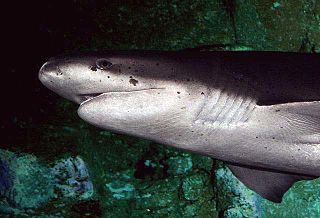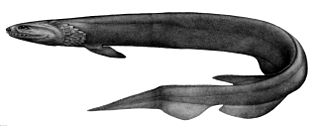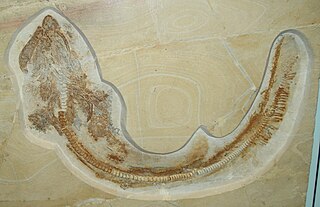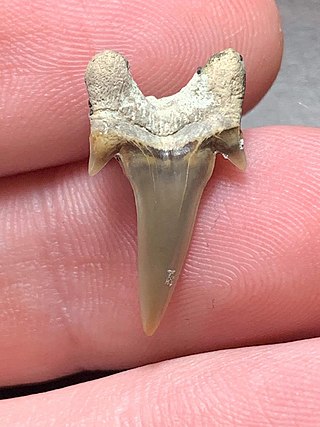
The Hexanchiformes are a primitive order of sharks, that numbering just seven extant species in two families. Fossil sharks that were apparently very similar to modern sevengill species are known from Jurassic specimens.

The frilled shark, also known as the lizard shark, is one of the two extant species of shark in the family Chlamydoselachidae. The frilled shark is considered a living fossil, because of its primitive, anguilliform (eel-like) physical traits, such as a dark-brown color, amphistyly, and a 2.0 m (6.6 ft)–long body, which has dorsal, pelvic, and anal fins located towards the tail. The common name, frilled shark, derives from the fringed appearance of the six pairs of gill slits at the shark's throat.

Chlamydoselachidae is a family of primitive deep-sea sharks in the order Hexanchiformes. They are one of only two extant families in the order alongside the cow sharks in the family Hexanchidae, and the only members of the suborder Chlamydoselachoidei.

The Lamniformes are an order of sharks commonly known as mackerel sharks. It includes some of the most familiar species of sharks, such as the great white, as well as more unusual representatives, such as the goblin shark and megamouth shark.

Squalicorax, commonly known as the crow shark, is a genus of extinct lamniform shark known to have lived during the Cretaceous period. The genus had a global distribution in the Late Cretaceous epoch. Multiple species within this genus are considered to be wastebasket taxon due to morphological similarities in the teeth.

Cretoxyrhina is an extinct genus of large mackerel shark that lived about 107 to 73 million years ago during the late Albian to late Campanian of the Late Cretaceous. The type species, C. mantelli, is more commonly referred to as the Ginsu shark, first popularized in reference to the Ginsu knife, as its theoretical feeding mechanism is often compared with the "slicing and dicing" when one uses the knife. Cretoxyrhina is traditionally classified as the likely sole member of the family Cretoxyrhinidae but other taxonomic placements have been proposed, such as within the Alopiidae and Lamnidae.

Chlamydoselachus is a genus of sharks and the sole extant member of the family Chlamydoselachidae, in the order Hexanchiformes. It contains two extant and four extinct species. The most widely known species still surviving is the frilled shark. It is known as a living fossil, along with Chlamydoselachus africana, also known as the southern African frilled shark, which is only found along coastal areas of South Africa. The only two extant species of this genus are deep-sea creatures which are typically weakened in areas closer to the surface. While the two extant species are similar in external appearance, they differ internally.

Hybodus is an extinct genus of hybodont, a group of shark-like euselachians that lived from the Late Devonian to the end of the Cretaceous. Species closely related to the type species Hybodus reticulatus lived during the Early Jurassic epoch. Numerous species have been assigned to Hybodus spanning a large period of time, and it is currently considered a wastebasket taxon that is 'broadly polyphyletic' and requires reexamination.

Hybodontiformes, commonly called hybodonts, are an extinct group of shark-like cartilaginous fish (chondrichthyans) which existed from the late Devonian to the Late Cretaceous. Hybodonts share a close common ancestry with modern sharks and rays (Neoselachii) as part of the clade Euselachii. They are distinguished from other chondrichthyans by their distinctive fin spines and cephalic spines present on the heads of males. An ecologically diverse group, they were abundant in marine and freshwater environments during the late Paleozoic and early Mesozoic, but were rare in open marine environments by the end of the Jurassic, having been largely replaced by modern sharks, though they were still common in freshwater and marginal marine habitats. They survived until the end of the Cretaceous, before going extinct.

Paraorthacodus is an extinct genus of shark. It a member of the family Paraorthacodontidae, which is either placed in Hexanchiformes or in Synechodontiformes. It is known from over a dozen named species spanning from the Early Jurassic to the Paleocene, or possibly Eocene. Almost all members of the genus are exclusively known from isolated teeth, with the exception of P. jurensis from the Late Jurassic-Early Cretaceous of Europe, which is known from full body fossils from the Late Jurassic of Germany, which suggest that juveniles had a robust body with a round head, while adults had large body sizes with a fusiform profile. There was only a single dorsal fin towards the back of the body without a fin spine. The dentition had teeth with a single large central cusp along with shorter lateral cusplets, which where designed for clutching. The teeth are distinguished from those of Synechodus by the lateral cusplets decreasing in size linearly away from the central cusp rather than exponentially as in Synechodus.
Anomoeodus is an extinct genus of prehistoric marine ray-finned fish belonging to the family Pycnodontidae. This genus lived during the Late Cretaceous period, ranging from the Albian to Maastrichtian ages, and had a wide geographic distribution, with fossils found in France, Belgium, the Netherlands, Spain, Egypt, Uzbekistan, and the United States. Some studies have recovered it as a wastebasket taxon. The first fossils of Anomoeodus were described by Louis Agassiz in 1833, although they were described under Pycnodus.

Lonchidion is a genus of extinct hybodont in the family Lonchidiidae. The genus first appears in the fossil record during the Middle Triassic (Ladinian) and was among the last surviving hybodont genera, with its youngest known fossils dating to the very end of the Cretaceous (Maastrichtian).

Meristodonoides is an extinct genus of hybodont. The type species is M. rajkovichi, which was originally a species in the genus Hybodus. The species, along with other Hybodus species such as H. butleri and H. montanensis, was reassigned to Meristodonoides by Charlie J. Underwood and Stephen L. Cumbaa in 2010. The species is primarily known from remains from the Cretaceous of North America, spanning from the Aptian/Albian to Maastrichtian, making it one of the last surviving hybodont genera, though records of the genus likely extend back as far as the Late Jurassic, based on an undescribed skeleton from the Tithonian of England, and fragmentary teeth from the Kimmeridgian of Poland, England and Switzerland. Other remains of the genus are known from the Coniacian of England, the Aptian-Albian of France, and the Campanian of European Russia. The morphology of the teeth suggests an adaptation to tearing prey. Fossils from the Western Interior Seaway suggest that it preferred nearshore marine environments, being absent from deeper-water areas, with it likely also being able to tolerate brackish and freshwater conditions.

Synechodontiformes is an extinct order of prehistoric shark-like cartilaginous fish, known from the Permian to the Paleogene. They are considered to be members of Neoselachii, the group that contains modern sharks and rays.

Archaeolamna is an extinct genus of mackerel sharks that lived during the Cretaceous. It contains three valid species which have been found in Europe, North America, and Australia. While it is mostly known from isolated teeth, an associated set of teeth, jaws, cranial fragments, and vertebrae of A. kopingensis is known from the Pierre Shale of Kansas. Teeth of A. k. judithensis were found with a plesiosaur skeleton with bite marks from the Judith River Formation of Montana. It was a medium-sized shark with an estimated total body length of 3–4 metres (9.8–13.1 ft).

Pseudorhina is an extinct genus of squatiniform shark closely related to modern angelsharks. Fossils are known from the Late Jurassic and Early Cretaceous of Europe.
This list of fossil fish research presented in 2023 is a list of new taxa of jawless vertebrates, placoderms, acanthodians, fossil cartilaginous fishes, bony fishes, and other fishes that were described during the year, as well as other significant discoveries and events related to paleoichthyology that occurred in 2023.

Egertonodus is an extinct genus of shark-like hybodont fish. It includes E. basanus from the Jurassic of Europe and North Africa and Cretaceous of North America, North Africa and Europe, and E. duffini from the Middle Jurassic of England. Indeterminate remains of the genus have been reported from the Early Cretaceous of Asia. E. basanus is known from preserved skull material, while E. duffini is only known from teeth. The genus is distinguished from Hybodussensu stricto by characters of the skull and teeth. E. basanus, the most common species, is thought to have reached 1.5 m in length. E. fraasi from the Late Jurassic of Germany, known from a poorly preserved full body fossil, was placed in Egertonodus in one study, but this has been subsequently questioned by other authors, due to strong differences in tooth morphology from the type species. Fossils have been found in freshwater and lagoonal environments.
Rolfodon is an extinct genus of shark in the family Chlamydoselachidae. It is closely related to the extant frilled sharks in the genus Chlamydoselachus, which it can be differentiated from by tooth morphology. It is named after late Canadian paleontologist Rolf Ludvigsen.
Komoksodon is an extinct genus of hexanchiform shark known from the Late Cretaceous to the Paleocene. It is the only member of the monotypic family Komoksodontidae.















